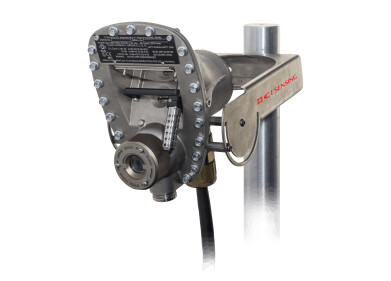-
 EDT with Bracket
EDT with Bracket -
 EDT Rimbleton School Fife
EDT Rimbleton School Fife
Air Monitoring
Low-cost air quality monitors inspire Scottish schoolchildren
Jun 17 2021
Clean Air Day (17th June) is being marked by hundreds of events across the United Kingdom. For example, Fife Council and sustainability consultancy, Ricardo, have provided three Scottish classes with education packs that enable children to conduct air quality monitoring in order to better understand the issue. Each pack contains a nitrogen dioxide monitoring device that has been developed by Alphasense, the sensor technology company.
Alphasense’s electronic diffusion tube (EDT) was designed to enable a rapid rollout of air quality monitoring in the places that matter most. So, the EDT is an ideal tool to support the theme for this year’s Clean Air Day: protecting children's health from air pollution.
Ricardo is responsible for auditing the air quality monitoring of councils, on behalf of the Scottish Government, but Senior Consultant Susannah Telfer says: “This work extends to assistance with the provision of educational programmes and resources such as those provided by Fife Council and the Air Quality in Scotland website".
In addition to the Alphasense EDT, each pack also contains a handheld tablet for communication with the EDT via Bluetooth, as well as a personal air quality monitor, a clipboard, some high vis vests, and a range of Ricardo items that have been assembled for educational purposes, such as bicycle bells and luminous bands. The pack is therefore designed to enable students to conduct lichen or traffic surveys for example, so that, in combination with the monitoring, they will better understand the factors affecting air quality. The EDT’s have therefore been installed to monitor in locations close to the schools’ drop off and collection points.
Explaining the importance of the EDT’s development, Alphasense’s CTO John Saffell says: “Diffusion tubes have been a popular low-cost air quality monitoring tool for decades, but they have a number of important limitations. They can be conveniently located almost anywhere, but they only provide an average reading over several weeks, and results are delayed until after laboratory analysis can be undertaken.
“The EDT resolves these issues whilst retaining the advantages of flexibility, convenience and low cost. This is because the EDT contains an advanced electrochemical sensor that logs readings and transmits data to a tablet or mobile phone running the EDT App. Nitrogen dioxide is the most popular parameter for air quality studies, but many of our other electrochemical cells can also be deployed in an EDT.”
Susannah Telfer says: “The EDTs have been set to log one minute averages and will collect continuous air quality data for up to three weeks. This will enable us to provide the schools with air quality graphs that will hopefully demonstrate the effects of vehicle movements.
“With the benefit of this project, the pupils will gain a better understanding of the causes and effects of pollution, so that they can choose to cycle and walk more and lobby their parents to use vehicles less often. We also hope that this will inspire the children and help to create the next generation of scientists.”
Digital Edition
AET 28.2 April/May 2024
May 2024
Business News - Teledyne Marine expands with the acquisition of Valeport - Signal partners with gas analysis experts in Korea Air Monitoring - Continuous Fine Particulate Emission Monitor...
View all digital editions
Events
Jul 10 2024 Birmingham, UK
Jul 21 2024 Cape Town, South Africa
Australasian Waste & Recycling Expo
Jul 24 2024 Sydney, Australia
Jul 30 2024 Jakarta, Indonesia
China Energy Summit & Exhibition
Jul 31 2024 Beijing, China

















